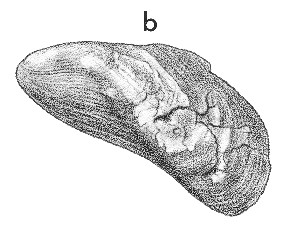
Revised descriptions of New Zealand Cenozoic Mollusca from Beu and Maxwell (1990)

 | Revised descriptions of New Zealand Cenozoic Mollusca from Beu and Maxwell (1990) | 
|
  (Pl. 39b): GS12857, V20/f136, estuarine beds with common Barytellina and Pseudocardium, Kaiwaka South Road, south-west of Devil's Elbow, 30 km north of Napier, Nukumaruan (GNS) |
Beu & Maxwell (1990): Chapter 15; p. 309; pl. 39 b.
Synonymy: Modiolus huttoni Suter 1914, p. 39; Xenostrobus huttoni, Beu & Maxwell 1990, p. 309, pl. 39b; Limnoperna huttoni, Beu 2006, p. 191
Classification: Mytilidae: Modiolinae
Description: Large for genus (to 100 mm long), thick-shelled, with rounded, inflated anterior end and weakly protruding, clearly subterminal umbones, smooth except for weak growth ridges; prominent umbonal ridge extends to posterior ventral margin; markedly concave area present below ridge on most specimens. Edentulous; other interior features not visible. Black periostracum remains on many specimens; on others, calcitic shell stained pale brown, but retaining nacreous sheen on most specimens. Dorsal and ventral margins diverge at low angle; large shells develop a "humped", angled dorsal outline and concave ventral outline.
Comparison: Despite the lack of knowledge of the musculature, there is little doubt that Wilson's (1967, p. 292) assignment of Modiolus huttoni to Xenostrobus is correct. However, as noted under L. altijugata, Beu (2006, pp. 188-191) showed that Limnoperna Rochebrune, 1882 is an earlier name for Xenostrobus Wilson, 1967. The large size distinguishes L. huttoni from all modern species, but the umbonal shape is similar to that of the southern Australian Recent species L. inconstans (Dunker); large shells develop a more curved, "humped" outline than L. inconstans, resembling in outline the Australian and New Zealand Recent species L. securis . The ecological station favoured by L. huttoni appears to have been very similar to that of L. securis, which lives in large numbers in brackish lakes. The other, smaller New Zealand Recent species, L. pulex (Lamarck, 1819), forms dense carpets byssally attached to exposed intertidal rocks in fully marine to slightly lowered salinity. L. altijugata (Pl. 28d) appears to be an earlier species of Limnoperna with a still more curved, "humped" outline than L. huttoni.
Distribution: Waipipian-Castlecliffian; conglomeratic shellbeds, Lower Waipara Gorge near Greenwood's Bridge, North Canterbury, Waipipian (type); also Middle Waipara River near "The Deans", Waipipian or Mangapanian; common in several very shallow-water formations in Wanganui basin (Nukumaruan and Castlecliffian) and in several estuarine mudstone beds in Hawke's Bay and Wairarapa (Nukumaruan). The youngest record is from an estuarine shellbed underlying Tainui Shellbed (oxygen isotope stage 13) on the Whangaehu-Turakina interfluve, east of Wanganui. An estuarine "mussel", occurring with Barytellina, Cyclomactra, Zeacumantus and, at some localities, Pseudocardium, Austrovenus and Amphibola.
Cite this publication as: "A.G. Beu and J.I. Raine (2009). Revised
descriptions of New Zealand Cenozoic Mollusca from Beu and Maxwell (1990). GNS
Science miscellaneous series no. 27."
© GNS Science, 2009
ISBN
978-0-478-19705-1
ISSN 1177-2441
(Included with a PDF facsimile file
copy of New Zealand Geological Survey Paleontological Bulletin 58 in CD version
from: Publications Officer, GNS Science, P.O. Box 30368 Lower Hutt, New
Zealand)